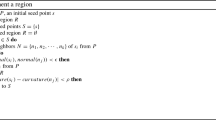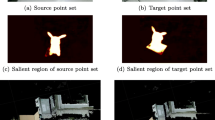Abstract
Point cloud registration is fundamental for generating a complete 3D scene from partial scenes obtained using 3D scanners. The key to the success of the task is extracting consistent descriptor values from arbitrary rotations (that is, rotation-robust) and selecting salient descriptors between the discriminative and noise regions. However, extracting rotation-invariant features and setting a criterion for selecting salient descriptors are difficult. In this study, we present a new method for building salient and rotation-robust 3D local descriptors for point registration tasks. For each point, we first extracted neighboring points (patches) for each interest point and aligned them with their local reference frame. Next, we encoded the aligned patches using cylindrical kernels to obtain rotation-invariant descriptors. Then, we estimated dissimilarities between the descriptors to exclude descriptors extracted from monotonous and repeating areas and select discriminative descriptors, and registration tasks were performed using only the salient descriptors. We experimented with our method on indoor and outdoor datasets (3DMatch and ETH) to evaluate its performance. The performance of our method is comparable to that of state-of-the-art methods using discriminative rotation-invariant descriptors. By selecting salient descriptors, we improved our feature-matching recall scores by up to 3%.








Similar content being viewed by others
Data availability
Data sharing not applicable to this article as no datasets were generated or analyzed during the current study.
References
Hagbi N, Bergig O, El-Sana J, Billinghurst M (2010) Shape recognition and pose estimation for mobile augmented reality. IEEE Trans Visual Comput Graphics 17(10):1369–1379. https://doi.org/10.1109/ismar.2009.5336498
Placitelli AP, Gallo L (2011) Low-cost augmented reality systems via 3D point cloud sensors. In 2011 Seventh International Conference on Signal Image Technology & Internet-Based Systems (pp 188–192). IEEE. https://doi.org/10.1109/sitis.2011.43
Zhu Y, Mottaghi R, Kolve E, Lim JJ, Gupta A, Fei-Fei L, Farhadi A (2017) Target-driven visual navigation in indoor scenes using deep reinforcement learning. In 2017 IEEE International Conference on Robotics and Automation (ICRA) (pp 3357–3364). IEEE. https://doi.org/10.1109/icra.2017.7989381
Rusu RB, Marton ZC, Blodow N, Dolha M, Beetz M (2008) Towards 3D point cloud based object maps for household environments. Robot Auton Syst 56(11):927–941. https://doi.org/10.1016/j.robot.2008.08.005
Fraundorfer F, Scaramuzza D (2012) Visual odometry: Part II: Matching robustness, optimization, and applications. IEEE Robot Autom Mag 19(2):78–90. https://doi.org/10.1109/mra.2012.2182810
Liang M, Yang B, Wang S, Urtasun R (2018) Deep continuous fusion for multi-sensor 3D object detection. In Proceedings of the European Conference on Computer Vision (ECCV) (pp 641–656). https://doi.org/10.1007/978-3-030-01270-0_39
Pylvanainen T, Roimela K, Vedantham R, Itaranta J, Grzeszczuk R (2010) Automatic alignment and multi-view segmentation of street view data using 3D shape priors. In Symposium on 3D Data Processing, Visualization, and Transmission (3DPVT) 737:738–739
Kumar M, Jindal MK, Kumar M (2022) Distortion, rotation and scale invariant recognition of hollow Hindi characters. Sādhanā 47(2):92. Springer. https://doi.org/10.1007/s12046-022-01847-w
Zeng A, Song S, Nießner M, Fisher M, Xiao J, Funkhouser T (2017) 3DMatch: Learning the matching of local 3D geometry in range scans. In CVPR (vol. 1, p 4)
Pomerleau F, Liu M, Colas F, Siegwart R (2012) Challenging data sets for point cloud registration algorithms. Int J Robot Res 31(14):1705–1711. https://doi.org/10.1177/0278364912458814
Salti S, Tombari F, Di Stefano L (2014) Shot: Unique signatures of histograms for surface and texture description. Comput Vision Image Underst 125. https://doi.org/10.1016/j.cviu.2014.04.011
Rusu RB, Blodow N, Beetz M (2009) Fast point feature histograms (fpfh) for 3D registration. In 2009 IEEE International Conference on Robotics and Automation (pp 3212–3217). https://doi.org/10.1109/ROBOT.2009.5152473
Guo Y, Bennamoun M, Sohel F, Lu M, Wan J, Zhang J (2014) Performance evaluation of 3D local feature descriptors. In Asian Conference on Computer Vision (pp 178–194). Springer. https://doi.org/10.1007/978-3-319-16808-1_13
Phan AV, Nguyen ML, Nguyen YLH, Bui LT (2018) Dgcnn: A convolutional neural network over large-scale labeled graphs. Neural Netw 108:533–543. https://doi.org/10.1016/j.neunet.2018.09.001
Zhang K, Hao M, Wang J, Chen X, Leng Y, de Silva CW, Fu C (2021) Linked dynamic graph cnn: Learning through point cloud by linking hierarchical features. IEEE. https://doi.org/10.1109/M2VIP49856.2021.9665104
Hua B-S, Tran M-K, Yeung S-K (2018) Pointwise convolutional neural networks. In Proceedings of the IEEE Conference on Computer Vision and Pattern Recognition (pp 984–993). https://doi.org/10.1109/CVPR.2018.00109
Atzmon M, Maron H, Lipman Y (2018) Point convolutional neural networks by extension operators. ACM Trans Graph 37(4). https://doi.org/10.1145/3197517.3201301
Shen W, Zhang B, Huang S, Wei Z, Zhang Q (2020) 3D-rotation-equivariant quaternion neural networks. In Computer Vision – ECCV 2020: 16th European Conference, Glasgow, UK, August 23–28, 2020, Proceedings, Part XX (pp 531–547). Springer Berlin Heidelberg. https://doi.org/10.1007/978-3-030-58565-5_32
Rao Y, Lu J, Zhou J (2019) Spherical fractal convolutional neural networks for point cloud recognition. In 2019 IEEE/CVF Conference on Computer Vision and Pattern Recognition (CVPR) (pp 452–460). https://doi.org/10.1109/CVPR.2019.00054
Zhang Z, Hua B-S, Rosen DW, Yeung S-K (2019) Rotation invariant convolutions for 3D point clouds deep learning. In 2019 International Conference on 3D Vision (3DV) (pp 204–213). https://doi.org/10.1109/3DV.2019.00031
Chen C, Li G, Xu R, Chen T, Wang M, Lin L (2019) Clusternet: Deep hierarchical cluster network with rigorously rotation-invariant representation for point cloud analysis. In 2019 IEEE/CVF Conference on Computer Vision and Pattern Recognition (CVPR) (pp 4989–4997). https://doi.org/10.1109/CVPR.2019.00513
Li X, Li R, Chen G, Fu C-W, Cohen-Or D, Heng P-A (2022) A rotation-invariant framework for deep point cloud analysis. IEEE Trans Visual Comput Graph 28(12):4503–4514. https://doi.org/10.1109/TVCG.2021.3092570
Zhang Z, Hua B-S, Yeung S-K (2022) Riconv++: Effective rotation invariant convolutions for 3D point clouds deep learning. Int J Comput Vision 130(5):1228–1243. https://doi.org/10.1007/s11263-022-01601-z
Gojcic Z, Zhou C, Wegner JD, Wieser A (2019) The perfect match: 3D point cloud matching with smoothed densities. In 2019 IEEE/CVF Conference on Computer Vision and Pattern Recognition (CVPR) (pp 5540–5549). https://doi.org/10.1109/CVPR.2019.00569
Poiesi F, Boscaini D (2021) Distinctive 3D local deep descriptors. In 2020 25th International Conference on Pattern Recognition (ICPR) (pp 5720–5727). IEEE. https://doi.org/10.1109/icpr48806.2021.9411978
Poiesi F, Boscaini D (2022) Learning general and distinctive 3D local deep descriptors for point cloud registration. IEEE Trans Pattern Anal Mach Intell. https://doi.org/10.1109/tpami.2022.3175371
Bai X, Luo Z, Zhou L, Fu H, Quan L, Tai C-L (2020) D3feat: Joint learning of dense detection and description of 3D local features. In Proceedings of the IEEE/CVF Conference on Computer Vision and Pattern Recognition (pp 6359–6367). https://doi.org/10.1109/cvpr42600.2020.00639
Jung S, Shin Y-G, Chung M (2023) Robust kernel-based feature representation for 3D point cloud analysis via circular convolutional network. https://doi.org/10.1016/j.cviu.2023.103678. [Accessed from: https://www.sciencedirect.com/science/article/pii/S1077314223000589]
Johnson AE, Hebert M (1999) Using spin images for efficient object recognition in cluttered 3D scenes. IEEE Trans Pattern Anal Mach Intell 21(5):433–449. https://doi.org/10.1109/34.765655
Rusu R, Blodow N, Marton Z, Beetz M (2008) Aligning point cloud views using persistent feature histograms. In Proceedings of the IEEE/RSJ International Conference on Intelligent Robots and Systems (pp 3384–3391). https://doi.org/10.1109/IROS.2008.4650967
Tombari F, Salti S, Di Stefano L (2010) Unique shape context for 3D data description. https://doi.org/10.1145/1877808.1877821
Frome A, Huber D, Kolluri R, Bülow T, Malik J (2004) Recognizing objects in range data using regional point descriptors. In Proceedings of the Third International Symposium on 3D Data Processing, Visualization, and Transmission (vol 3, pp 224–237). https://doi.org/10.1007/978-3-540-24672-5_18
Deng H, Birdal T, Ilic S (2018) Ppfnet: Global context aware local features for robust 3D point matching. In 2018 IEEE/CVF Conference on Computer Vision and Pattern Recognition (pp 195–205). https://doi.org/10.1109/CVPR.2018.00028
Deng H, Birdal T, Ilic S (2018) PPF-FoldNet: Unsupervised learning of rotation invariant 3D local descriptors. In European Conference on Computer Vision (ECCV).https://doi.org/10.1007/978-3-030-01228-1_37
Choy C, Park J, Koltun V (2019) Fully convolutional geometric features. In 2019 IEEE/CVF International Conference on Computer Vision (ICCV) (pp 8957–8965). https://doi.org/10.1109/ICCV.2019.00905
Choy C, Gwak J, Savarese S (2019) 4D spatio-temporal convnets: Minkowski convolutional neural networks. In Proceedings of the IEEE/CVF Conference on Computer Vision and Pattern Recognition (pp 3070–3079). https://doi.org/10.1109/CVPR.2019.00319
Horache S, Deschaud J-E, Goulette, F (2021) 3D point cloud registration with multi-scale architecture and unsupervised transfer learning. In 2021 International Conference on 3D Vision (3DV) (pp 1351–1361). IEEE. https://doi.org/10.1109/3dv53792.2021.00142
Thomas H, Qi CR, Deschaud J, Marcotegui B, Goulette F, Guibas L (2019) KPConv: Flexible and deformable convolution for point clouds. In 2019 IEEE/CVF International Conference on Computer Vision (ICCV) (pp 6410–6419). https://doi.org/10.1109/ICCV.2019.00651
Li L, Fu H, Ovsjanikov M (2022) WSDESC: Weakly supervised 3D local descriptor learning for point cloud registration. IEEE Trans Visual Comput Graphics. https://doi.org/10.1109/tvcg.2022.3160005
Ao S, Hu Q, Yang B, Markham A, Guo Y (2021) SpinNet: Learning a general surface descriptor for 3D point cloud registration. In Proceedings of the IEEE/CVF Conference on Computer Vision and Pattern Recognition (pp 11753–11762). https://doi.org/10.1109/cvpr46437.2021.01158
Qi CR, Yi L, Su H, Guibas LJ (2017) PointNet++: Deep hierarchical feature learning on point sets in a metric space. In Advances in Neural Information Processing Systems 30: Annual Conference on Neural Information Processing Systems 2017, December 4–9, 2017, Long Beach, CA, USA (pp 5099–5108)
Valentin J, Dai A, Niessner M, Kohli P, Torr P, Izadi S, Keskin C (2016) Learning to navigate the energy landscape. In 2016 Fourth International Conference on 3D Vision (3DV) (pp 323–332). https://doi.org/10.1109/3DV.2016.41
Shotton J, Glocker B, Zach C, Izadi S, Criminisi A, Fitzgibbon A (2013) Scene coordinate regression forests for camera relocalization in RGB-D images. In 2013 IEEE Conference on Computer Vision and Pattern Recognition (pp 2930–2937). https://doi.org/10.1109/CVPR.2013.377
Xiao J, Owens A, Torralba A (2013) Sun3D: A database of big spaces reconstructed using SFM and object labels. In 2013 IEEE International Conference on Computer Vision (pp 1625–1632). https://doi.org/10.1109/ICCV.2013.458
Lai K, Bo L, Fox D (2014) Unsupervised feature learning for 3D scene labeling. In 2014 IEEE International Conference on Robotics and Automation (ICRA) (pp 3050–3057). https://doi.org/10.1109/ICRA.2014.6907298
Halber M, Funkhouser T (2016) Structured global registration of RGB-D scans in indoor environments. arXiv preprint arXiv:1607.08539
Fischler MA, Bolles RC (1981) Random sample consensus: A paradigm for model fitting with applications to image analysis and automated cartography. Commun ACM 24(6):381–395. https://doi.org/10.1016/b978-0-08-051581-6.50070-2
Li L, Zhu S, Fu H, Tan P, Tai C-L (2020) End-to-end learning local multi-view descriptors for 3D point clouds. In Proceedings of the IEEE/CVF Conference on Computer Vision and Pattern Recognition (pp 1919–1928). https://doi.org/10.1109/cvpr42600.2020.00199
Khoury M, Zhou Q-Y, Koltun V (2017) Learning compact geometric features. In Proceedings of the IEEE International Conference on Computer Vision (pp 153–161). https://doi.org/10.1109/iccv.2017.26
Spezialetti R, Salti S, Di Stefano L (2019) Learning an effective equivariant 3D descriptor without supervision. In Proceedings of the IEEE/CVF International Conference on Computer Vision (pp 6401–6410). https://doi.org/10.1109/ICCV.2019.00650
Charles RQ, Su H, Kaichun M, Guibas LJ (2017) PointNet: Deep learning on point sets for 3D classification and segmentation. In 2017 IEEE Conference on Computer Vision and Pattern Recognition (CVPR) (pp 77–85). https://doi.org/10.1109/CVPR.2017.16
Funding
This research was partly supported by the MSIT(Ministry of Science and ICT), Korea, under the Innovative Human Resource Development for Local Intellectualization support program(IITP-2024-RS-2022-00156360) supervised by the IITP(Institute for Information & communications Technology Planning & Evaluation). This work was partly supported by the Material&parts technology development project (20024280, Development of a Focused Ultrasound Therapeutic Device for BBB Opening and Neuromodulation) funded By the Ministry of Trade, Industry & Energy(MOTIE, Korea).
Author information
Authors and Affiliations
Corresponding author
Ethics declarations
Conflict of interest
None declared.
Additional information
Publisher's Note
Springer Nature remains neutral with regard to jurisdictional claims in published maps and institutional affiliations.
Rights and permissions
Springer Nature or its licensor (e.g. a society or other partner) holds exclusive rights to this article under a publishing agreement with the author(s) or other rightsholder(s); author self-archiving of the accepted manuscript version of this article is solely governed by the terms of such publishing agreement and applicable law.
About this article
Cite this article
Jung, S., Shin, YG. & Chung, M. Point cloud registration with rotation-invariant and dissimilarity-based salient descriptor. Multimed Tools Appl (2024). https://doi.org/10.1007/s11042-024-18577-2
Received:
Revised:
Accepted:
Published:
DOI: https://doi.org/10.1007/s11042-024-18577-2




